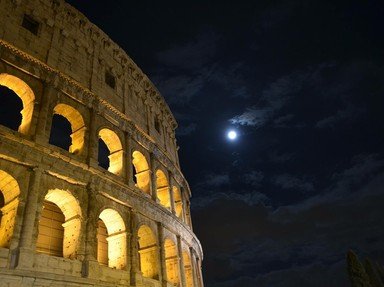Quiz Answer Key and Fun Facts
1. Back in Ancient Rome, the trend of the time was to cremate dead bodies, but Christians and Jews believed in burial. Certain places were created to house the bodies of the dead who couldn't afford the expense of Roman real estate. These places were several stories tall and were some of the best examples of early Christian and Jewish art. Rhonda enjoyed seeing them. What were they called?
2. Rhonda couldn't wait to see the Roman Colosseum. Standing three stories tall and made of concrete and marble, it is a memorial to the ingenuity of man. The construction began in 70-72 AD and took ten years to complete. The Flavian Emperors, who took over rule in 69 AD, consisted of a father and two sons who commissioned the Colosseum. Can you name the Patriarch?
3. During the time of the Ancient Roman Empire, a dilemma existed of how to get fresh water to where it was needed. In 98 AD, there existed a "guardian of the water" who used the system of aqueducts in Rome to transport water to fountains and private homes. Fountains allowed people to get access to fresh water. Modern Rome has more than 2000 fountains, and Rhonda saw quite a few of them. Which is the largest one?
4. When Ancient Rome was being settled as far back as 1000 BC, there were many reasons behind where leaders decided to situate the first cities. Rome itself was founded in 753 BC. There are two mountain ranges that offered protection and resources to the new cities. Rhonda got to visit them. What are the names of the two mountain ranges?
5. Venice, Italy is a short 3-5 hour train ride from Rome. Rhonda went to Venice for a couple of days. Its geography is so very interesting. It is located on the northeast corner of Italy and is bordered by the Adriatic Sea. It is an entire city built mostly on the water, with the Grand Canal going from end to end. What kind of transportation is not allowed anywhere on the main island of Venice, but is so very popular in Venice, California?
6. There is a Roman legend that after the fall of the hated tyrant Tarquinius Superbus in 510 BC, his body was tossed into the Tiber River. Salt and silt built up around it to form an island. This island has been connected to Rome, via two bridges, since the beginning of recorded time. Before Christianity, this place was avoided due to scary stories. Later it became an island dedicated to the gods of medicine and healing. Rhonda wasn't afraid to visit it. What is the name of this island?
7. Located two hours south of Rome, Rhonda had to visit one of the most interesting geographical sites in the world. We have all heard of the destruction of Pompeii in 79 AD by the volcano Vesuvius. According to Pliny the Younger, more than just Pompeii was destroyed. Due to toxic gas, lava and ash from the eruption, two other Roman resort towns were also destroyed. What were these other two towns?
8. Roman history is filled with battles. Rhonda learned that after each battle a victory parade would be held in the center of Rome. What landmark was built after each big battle to commemorate the Roman victory?
9. For thousands of years, two agricultural items were found in Italy, as well as the entire Mediterranean area. Greeks settled in the area now known as Italy before the Roman armies ran them out. What two food items were these (which Rhonda enjoyed eating)?
10. Rhonda's last-visited locale has a checkered past. It is located in the northern part of Italy, and has warm summers and humid cold winters. It is about 322 miles from Rome. Over the course of history, it has been taken over by many invaders due to its important intersection of roads through the north. It was held by everyone from the Visigoths to Napoleon. It is very popular for its history and art. Name this place. (Hint: think Shakespeare)
Source: Author
cathyR88
This quiz was reviewed by FunTrivia editor
Pagiedamon before going online.
Any errors found in FunTrivia content are routinely corrected through our feedback system.

